|
Biography
1950
born in Nauheim, Germany
1975-79
Hochschule für Bildende Kuenste, Frankfurt/Main, Germany
1979-81
Hochschule für Bildende Kuenste, Duesseldorf, bei Prof. Klaus Rinke
1978-81
Scholarship of the Deutschen Studienstiftung
1985
Founding of the "Gruppe Formalhaut", with Gabriela Seifert und Goetz Stoeckmann
1992-93
Guest-Professor at the TU Graz (with "Formalhaut"), Austria
1994
Price-winner für Baukunst, Akademie der Künste Berlin (with "Formalhaut")
1997
art multiple-Price, Internationaler Kunstmarkt in Düsseldorf, Germany
1998
Wilhelm-Loth-Price, Darmstadt, Germany
1999
Professor and President of Akademie der Kuenste, Nuernberg, Germany
2002 Intermedien Award ZKM Karlsruhe, Germany
2005 President of the Akademie der Bildenden Kuenste, Nuernberg, Germany
lives and works in Frankfurt/Main und Wertheim, Germany
|
Exhibitions since 1980 (selection)
Gallery
ak, Frankfurt, Oberflächen, Germany
Het
Apollohuis, Eindhoven, Blinker, Netherland
Gallery ak, Frankfurt, Plastik, Germany
Provinciaal Museum, Hasselt/Belgium
Storefront
for Art & Architecture, New York (with "Formalhaut")
Gallery Transit, Leuven/Belgium, Nature Morte
Lindinger + Schmid, Regensburg, Germany
Familientreffen, Stadtraum Rüsselsheim, Germany
Lenbachhaus
Kunstforum, München, Eine Population, Germany
Fliegender Wechsel, Stadtraum Seligenstadt, Germany
Landesmuseum Oldenburg, Landschaft für Sprint, Germany
Kunstverein Ulm, Schmutziges Gelb, Germany
ACP Viviane Ehrli Gallery, Zürich, Monochrom für Enthusiasten
Städtische Galerie Ravensburg, Materialprüfung, Germany
Kunstverein Kirchzarten, Fingerübung, Germany
Wewerka Pavillon, Münster, Im Gordischen Stil, Germany
Welcome, Installation zu den Opernfestspielen in München, Germany
Kunstverein Würzburg, Germany
Forum Kunst Rottweil, Hydra, Germany
Neuer
Aschaffenburger Kunstverein, Aschaffenburg, Germany
"Das große Hasenstück", Nürnberg, Germany
artLAB,
'Wien, Austria
ARTBOX, Gallery für Editionen, Frankfurt, Germany
Die
Speisung der Fünftausend,
Projekt für das XI. Internationale Bodenseefestival
APC Gallery, Köln, Percuhion (with Bernd Vossmerbäumer)
"Richard Wagner für das 21. Jahrhundert", Bayreuth, Germany
"Eulen nach Athen", Athen, Greece
Arthur Rimbaud, Charleville-Mézières, France
Gallery
Erhard Witzel, Wiesbaden, Germany
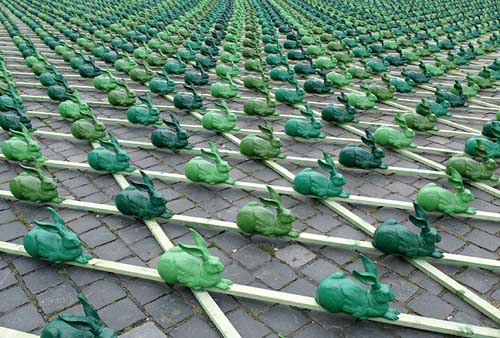
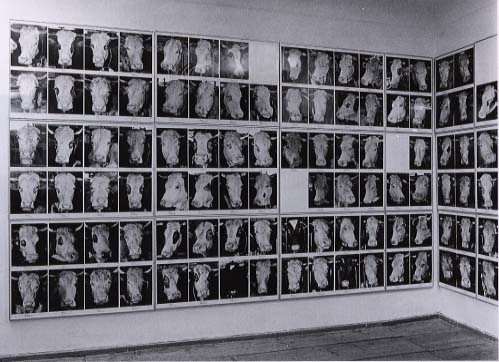
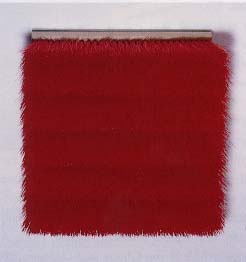
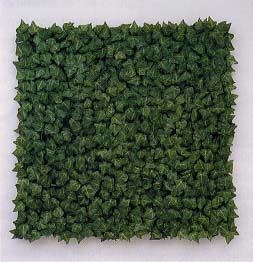
I understand
my work as an organizational principle, defined by and through space.
My pieces always have amore or less political intention, that means that they tend to make
statements about society.
Art is not a matter of dividing the world into Good and Evil, but rather it is a case that
art ,as one part of society , is moulded and defined by the will to unsettle and to
disregard or broaden hitherto inflexible conventions.O. H. 1999 |
Organized anarchy
Welcome! Four thousand garden-dwarves dressed in black and
white stretch out their hands to the visitors and bid them welcome to the Munich Opera
Festival. Although they are only small, their appearance is appropriate, their
presentation imposing, their choreography overwhelming. The visitors to the festival feel
at home and smile back at the dwarves. Then, among the thousand-headed horde they discover
a couple of anarchic exceptions, brightly coloured figures obscenely raising their middle
fingers. A filthy gesture? A dwarves´ revolt? A happening by Ottmar Hörl!
As unexpected and perplexing the parade of the dwarves might be for
the visitors, it is an articulate expression of the artistic method of its innovator and
director – his "principle of organized anarchy" (Hörl 1982). Whether, as
in his ‘Kuhprojekt’ (Cow-Project, 1986), he clothed each of a small herd of cows
with a well-fitting cover of transparent polyester, or he had a uniformed police-marksman
fire two shots at the glazed front of the Historical Museum in Frankfurt (‘By the
way’, 1991), or whether he had a camera filming its own fall from a towerblock
including its inevitable destruction on hitting the ground – in all of Hörl`s works
one encounters the contradiction of chaos and order, he always lays bare the structural
elements of our material and social environment and thinks them through to their logical
conclusion until, to use Dürrenmatt´s words, events have taken the worst turn possible.
In this way he is able to undermine the ceremonial monotony of the festival opening, to
render apparent the natural parallel alignment of cows and the danger that art becomes
museumified and also the mechanical logic of the camera as man´s extended arm and
extended eye.
The integrity of the material
As a consequence of Hörl´s principle question about the secret
rules of order and the multiplicity of the forms of hidden structures his artistic work is
not confined to one specific form of expression or style. Thus conventionally defined
sculpture, happenings, photographic works and drawings all stand on an equal basis. They
are united by Hörl´s specific attitude to the material involved and by the special
attention he pays to those objects that interest him. This can be described as respect for
the integrity of things and living beings alike. It is of great importance to Hörl that
the sculptured form does not arise in conflict with the material but rather out of its
formal inherent qualities, according to the intention "to make the use of the
material in relationship to the desired results understandable".
The investigation of the world as it is brings with it a rejection
of sculptural forms that result from subjective arbitrariness, the respect for the
integrity of the material, a rejection of the traditional forms of sculpture, that take
their shapes from the forceful wrenching out of a form from wood or stone. In their place
Hörl has found that industrially produced plastic, initially for the most part corrugated
polyester, as the more appropriate and contemporary material, not only because of its
increasing presence in modern industrial society, but also due to its inherent aptitude
for serial production.
The principle of the series
The principle of the series, developed on the production lines of
the automobile industry and taken up by all aspects of the consumer industry and perfected
by the genetics and media industries, embodies a structural element of modern society.
Hörl takes this into account in that he integrates it as a constitutive moment in the
system of his sculptural concept. The sculpture ‘Zwilling’ from 1986 can be
regarded as a quantum leap in this process of perception. With its screwed together layers
of corrugated polyester Hörl, for the first time, doubles the form and in this way
underlines its structural repeatability and principle availability. For the same reason
the police marksman in Frankfurt had to fire two shots at the museum and not just one. It
was only in this way that the action became systematical and was liberated from the
character of an arbitrary deed and became apparent as a structural intervention.
The definition of the scope of a series is thus a factor not to be
neglected and is often an important conceptional element in Hörl´s work. Ottmar Hörl
takes great pains to always gain sight of the totality of a social manifestation. For
instance, if he reveals what it means, when there is talk every day of the threat faced by
numerous populations of the earth and to this end hee presents a complete picture of the
cow-population of the city of Passau at a specific moment of time (‘Eine
Population’), then he cannot be satisfied wiiith one facet, but has to present the
portraits of every one of the 943 cows living at this time in the municipal area of
Passau. And also his extremely successful multiple ‘Unschuld’ (Innocence, 1997),
a bar of soap in a plastic box, achieves its particular virulence through the fact, that
the number made, 82 million, corresponds exactly to the population of germany.
Nature , Art, Society
Hörl´s interventions occur in the tense relationship between art,
nature and society. The dialectic of Art and Nature recognizable in his cow-projects, his
still-lives and his work with plastic plants is a representation of a thematic variation
of the higher question of the relationship of chaos and order. At first sight one might be
tempted to equate nature with chaos and art with order. This equation does not however
workout. Hörl shows this by making his broom-objects, symbols of the desire for order,
out of horsehair, while his proliferating green objects with grass, myrtle and ivy,
symbols of nature, are completely made of plastic.
Hörl’s social framework is most clearly apparent in his works
for public spaces. It is here that his idea of culture as a "link between a highly
developed technology and the completely ignored consciousness of mankind today" finds
its most effective place. For this reason Hörl pleads for a new seriousness in the
approach to art in public spaces: "Artists must learn to place their fingers on the
wounds of the public. That is not possible in isolated galleries and museums." Hörl
has shown just how this can be achieved in his numerous interventions in cities. Most
striking was his work ‘Street Gang’ (Aschaffenburg 1992), in which he installed
the complete range of 20 different rubbish containers according to the catalogue of their
manufacturer. The absurd grouping of the partly rustic and partly trendy containers not
only takes as its theme in an ironical manner the virulent rubbish problem of our cities,
nor is it solely an invitation to a functional and aesthetic comparison, above all it
undermines the certainty of salvation of a society that forever presents technological
solution to social questions. Just how far Hörl can be seen as an "offensive and
direct strategist of a new form of public art" is shown by a serial sculpture
‘Familientreffen’ (Family meeting, 1992) in and around the town of Rüsselsheim:
a multiple silhouette of the contemporary family developed from templates for
architectural drawings, which in its material (laquered steel), serial nature (industrial
production) and colour variety (multicultural workforce) reflects very precisely the
sociocultural situation of the car-producing city. And finally when Hörl , in one of his
latest works, plants a blue house at a precarious angle on a hill at the entrance to the
town of Ravensburg, then he marks by means of organized anarchy the sensitive transition
of the countryside to the town – a place which on account of the regular failings of
modern town planning is generally dominated by anarchic organization.
Sculpture as a principle of organization
In spite of their principle conception and in spite of the partially
rather strange appearance of the materials used, Hörl’s works are marked by a
pronounced aestheticism. By isolation and accumulation, arrangement and association,
progression and rhythmic presentation he succeeds in wringing new aesthetic qualities from
banally functional objects. When pipes are mutated to ‘Sculptures in Gordian
style’ (1998), this not only represents the ironic retroactive transformation of the
technological world into a mythical age, but also an ability to play with the beauty of
the bizarre. However much Hörl’s work deals with the questions of the confrontation
of natural and social reality, at the same time it always articulates the art-historical
and art immanent correlation. Thus aesthetics, irony and quotation, often to be found in
the titles, are essential aspects of his work. In conclusion, if one attempts to define
Hörl’s artistic strategy, then one can make use of the phrase he himself coined
"sculpture as a principle of organization". This encompasses two aspects: the
methods of the artist to order and structure objects of his choice according to their
physical and visual qualities in an experimental manner until they begin to shine and the
specific interest of the artist to trace the systems of social order, hidden as they are
in materials (ready-made plastic parts), tools (cameras, templates) and social functions
(opera festivals), and to think them through in the state of order to their conclusion and
thus provides at least an initial impulse to reflect upon their inherent sense.
Thomas Knubben (The author is the
Kulturreferent of Ravensburg and director of the Städtische Galerie Altes Theater.)
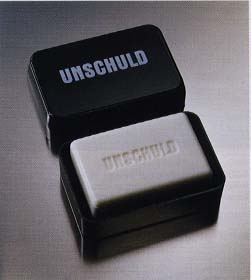 |
| |
|
|